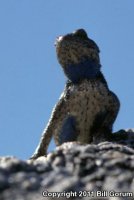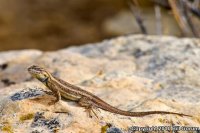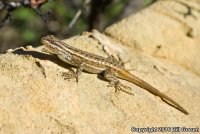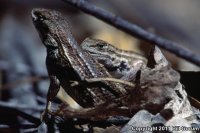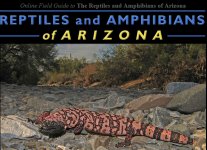| Range: |
 |
| Other Names: |
Spiny Lizard, Fence Lizard, Fence Swift |
| Description: |
A small (up to 76 mm or 3" from snout to vent), gray-brown to golden-brown lizard with pointed, keeled, overlapping scales and two light stripes on the back. The mid-dorsum is marked with a broad, gray stripe. Some specimens have small, dark blotches on the back between the stripes. Males have two large, bright blue patches on the belly. The belly patches are usually edged with dark gray or black. The underside of the throat is marked with two blue blotches, one on each side. The shoulder area is often dark gray. Belly patches are faint or lacking in females. Gravid females often have an orange or yellow tint on the back. |
| Similar Species: |
The paired throat blotches distinguish this lizard from the similar looking Common Sagebrush Lizard. Its lack of side blotches distinguishes it from the Common Side-blotched Lizard. Belly patches (in males) distinguish it from the Striped Plateau Lizard which has a plain belly. The scales on the sides of the body are arranged in diagonal rows (spines point up and back) distinguishing this lizard from Slevin's Bunchgrass Lizard. The Southwestern Fence Lizard is nearly identical to the Plateau Fence Lizard and the Prairie Lizard in appearance, but the three are genetically distinct from one another. The Prairie Lizard has very distinct stripes, edged with black down the outside of the back on either side. These stripes are not as distinct on Sceloporus cowlesi. |
| Venom: |
None |
| Habitat: |
Found in rocky areas and wooded areas.Occasionally seen in the plains if there is some scrub or rocky areas. I've noticed that they do really well in neighborhoods. |
| Behavior: |
During the summer this diurnal lizard is most active mid morning and late afternoon. In spring and fall it can be active all day long. It forages on the ground but climbs onto rocks, trees, fence posts, and wood piles to bask. |
| Hibernation: |
It hibernates during the cold months of winter and late fall. They will come out and bask on warm days during the winter. I have found them every month of the year |
| Reproduction: |
Mating begins in spring and continues into early summer. One to 4 clutches of eggs are laid in late spring and summer. Clutch size ranges from 1 to 10 eggs. Hatchlings begin to emerge in June and continue to emerge through September. |
| Diet: |
The Southwestern Fence Lizard sits and waits for prey to wander within close proximity. It feeds on a variety of insects including termites, ants, beetles, grasshoppers, flies, larvae, and wasps. It also eats a variety of spiders, snails, and small lizards. |




